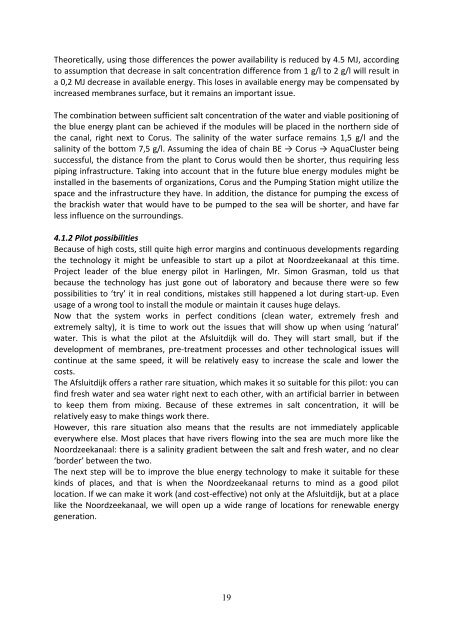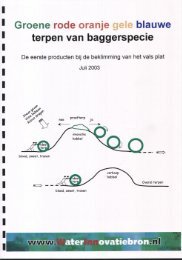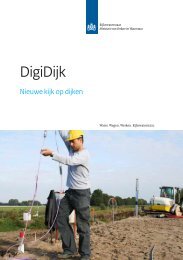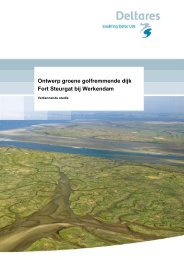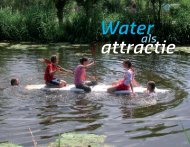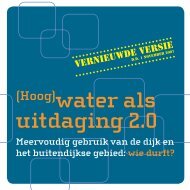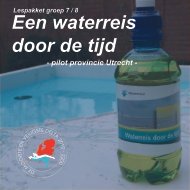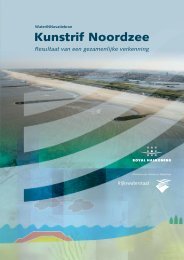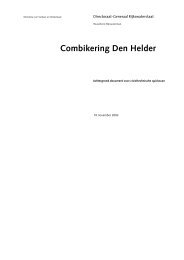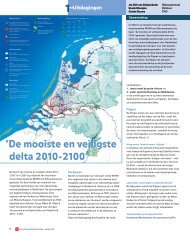Creating opportunities to adapt to climate change through innovative ...
Creating opportunities to adapt to climate change through innovative ...
Creating opportunities to adapt to climate change through innovative ...
Create successful ePaper yourself
Turn your PDF publications into a flip-book with our unique Google optimized e-Paper software.
Theoretically, using those differences the power availability is reduced by 4.5 MJ, according<strong>to</strong> assumption that decrease in salt concentration difference from 1 g/l <strong>to</strong> 2 g/l will result ina 0,2 MJ decrease in available energy. This loses in available energy may be compensated byincreased membranes surface, but it remains an important issue.The combination between sufficient salt concentration of the water and viable positioning ofthe blue energy plant can be achieved if the modules will be placed in the northern side ofthe canal, right next <strong>to</strong> Corus. The salinity of the water surface remains 1,5 g/l and thesalinity of the bot<strong>to</strong>m 7,5 g/l. Assuming the idea of chain BE → Corus → AquaCluster beingsuccessful, the distance from the plant <strong>to</strong> Corus would then be shorter, thus requiring lesspiping infrastructure. Taking in<strong>to</strong> account that in the future blue energy modules might beinstalled in the basements of organizations, Corus and the Pumping Station might utilize thespace and the infrastructure they have. In addition, the distance for pumping the excess ofthe brackish water that would have <strong>to</strong> be pumped <strong>to</strong> the sea will be shorter, and have farless influence on the surroundings.4.1.2 Pilot possibilitiesBecause of high costs, still quite high error margins and continuous developments regardingthe technology it might be unfeasible <strong>to</strong> start up a pilot at Noordzeekanaal at this time.Project leader of the blue energy pilot in Harlingen, Mr. Simon Grasman, <strong>to</strong>ld us thatbecause the technology has just gone out of labora<strong>to</strong>ry and because there were so fewpossibilities <strong>to</strong> ‘try’ it in real conditions, mistakes still happened a lot during start-up. Evenusage of a wrong <strong>to</strong>ol <strong>to</strong> install the module or maintain it causes huge delays.Now that the system works in perfect conditions (clean water, extremely fresh andextremely salty), it is time <strong>to</strong> work out the issues that will show up when using ‘natural’water. This is what the pilot at the Afsluitdijk will do. They will start small, but if thedevelopment of membranes, pre-treatment processes and other technological issues willcontinue at the same speed, it will be relatively easy <strong>to</strong> increase the scale and lower thecosts.The Afsluitdijk offers a rather rare situation, which makes it so suitable for this pilot: you canfind fresh water and sea water right next <strong>to</strong> each other, with an artificial barrier in between<strong>to</strong> keep them from mixing. Because of these extremes in salt concentration, it will berelatively easy <strong>to</strong> make things work there.However, this rare situation also means that the results are not immediately applicableeverywhere else. Most places that have rivers flowing in<strong>to</strong> the sea are much more like theNoordzeekanaal: there is a salinity gradient between the salt and fresh water, and no clear‘border’ between the two.The next step will be <strong>to</strong> improve the blue energy technology <strong>to</strong> make it suitable for thesekinds of places, and that is when the Noordzeekanaal returns <strong>to</strong> mind as a good pilotlocation. If we can make it work (and cost-effective) not only at the Afsluitdijk, but at a placelike the Noordzeekanaal, we will open up a wide range of locations for renewable energygeneration.19


